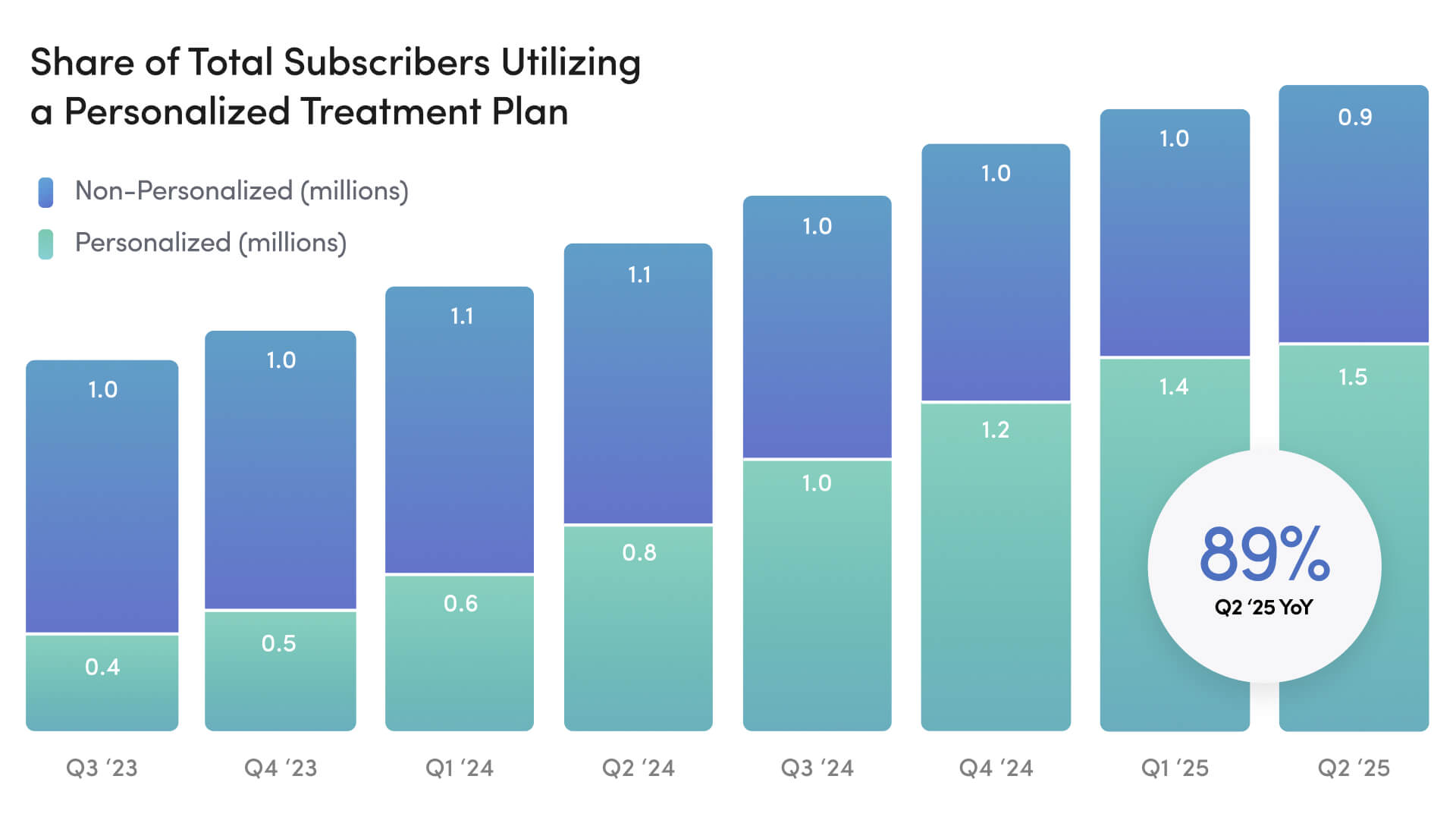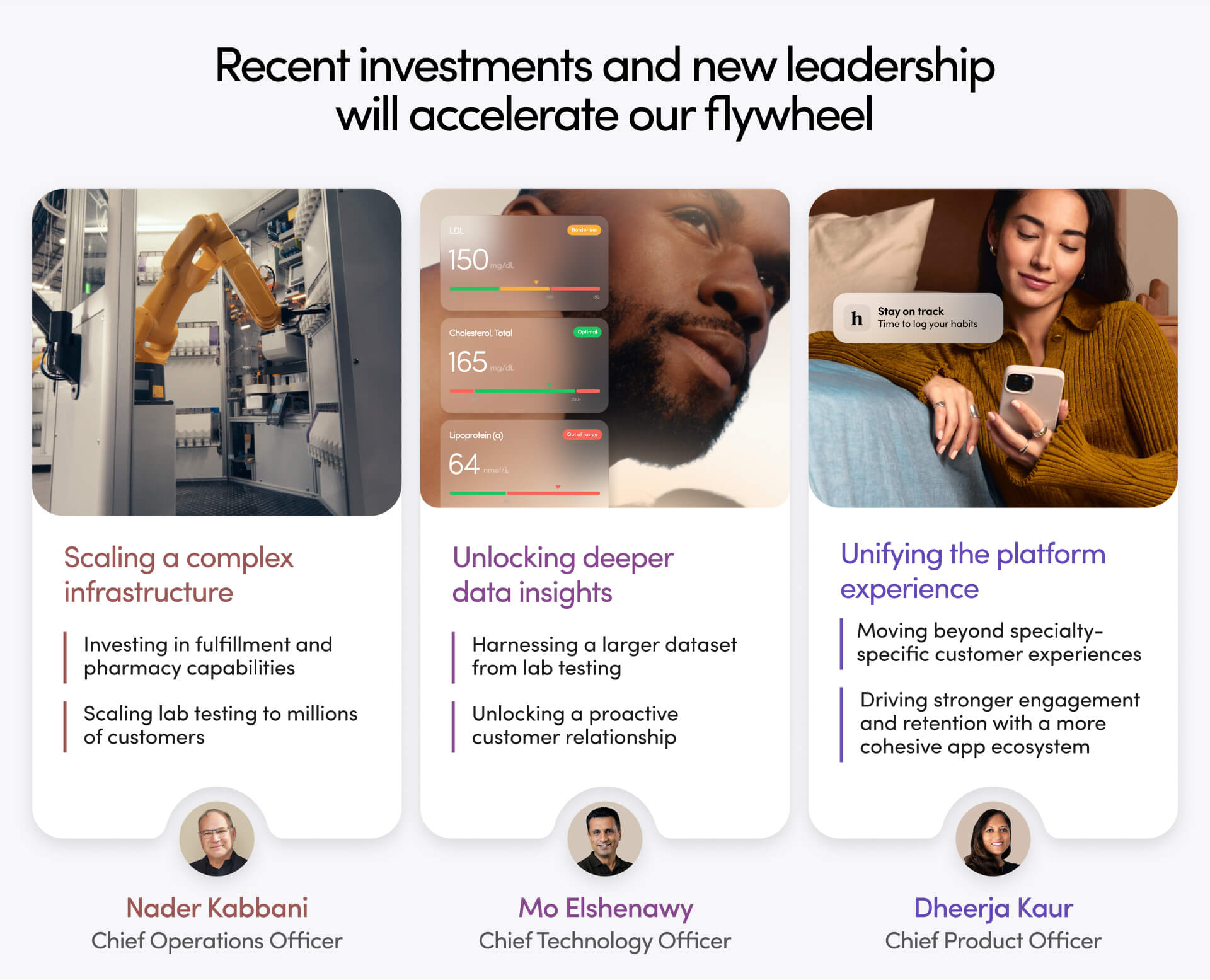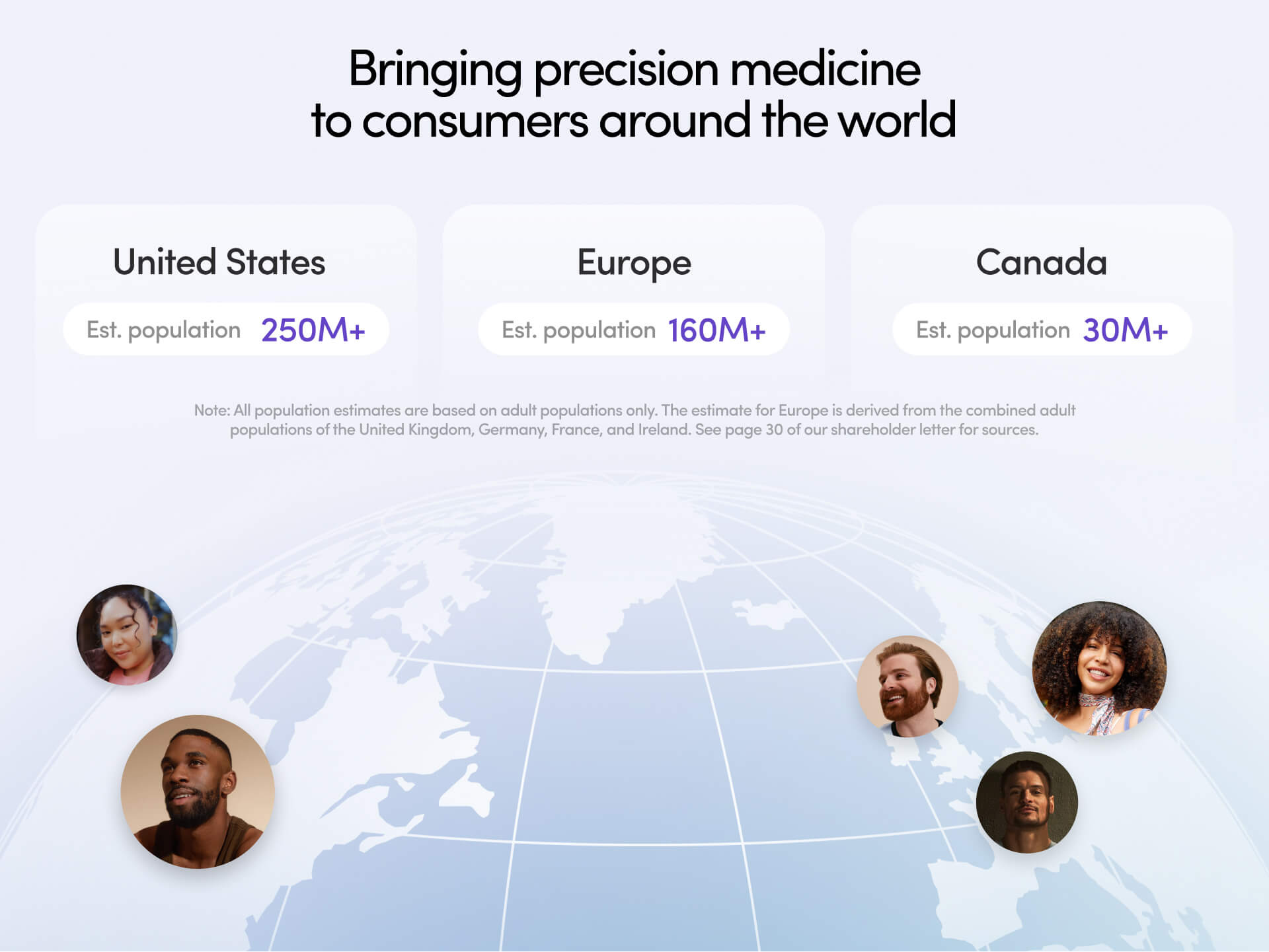It’s clear in the momentum of our business, the results our customers are experiencing, and the growing number of subscribers choosing our platform to access care tailored to their needs. Here’s what to know from today’s results:

We’re delivering consistent growth and scaling revenue and profitability while expanding access to personalized care. Year-over-year, revenue grew 73% to $545M, Adjusted EBITDA1 more than doubled, and our subscriber base grew 31%. There’s clear demand for personalization: nearly 1.5 million customers (that’s 89% growth year-over-year!) are utilizing a personalized treatment plan. That includes over 500K customers who are benefiting from treatment plans for multiple conditions – an almost 170% increase year-over-year. More people than ever are turning to our platform for treatment, and we’re seeing rapid growth in customers using personalized plans. Our model is working and accelerating.

We’re evolving from a telehealth company into a personalized health and wellness platform through strategic additions to our leadership team and continuing to add capabilities to both scale and deepen personalization. With investments in new capabilities like lab testing and strategic leadership hires across operations, technology, and product, we’re laying the groundwork to unlock deeper insights, stronger infrastructure, and a more unified experience. That’s how we’re meeting the moment and shaping what comes next in categories like hormone health and longevity. All of this builds the foundation for a future where a Hims & Hers membership could cover the majority of conditions that impact an individual's everyday health.

We’ve consistently shown we know how to turn strategic investments into impact, and we’re ready to have an impact on customers across the world as we continue to expand. In Q3 and Q4, we’re investing in international expansion, entering high-touch specialties, and executing against a strategy that’s proven to deliver for our customers.
With a world-class provider network, a growing set of tech capabilities, new treatment options, and experienced new leaders joining our bench, we’re on a strong trajectory to increase access to precision care for millions of people across the world. This isn’t just what we’ve believed in from the beginning – it is what the market is demanding. What we’ve built is working, and it’s working at scale.
1This is a non-GAAP financial measure. Please refer to the end of this post for definitions and reconciliations to the corresponding GAAP financial measure.
Cautionary Note Regarding Forward-Looking Statements
This communication includes forward-looking statements within the meaning of Section 27A of the Securities Act of 1933, as amended and Section 21E of the Securities Exchange Act of 1934, as amended. These forward-looking statements can be identified by the use of forward-looking terminology, including the words “believes,” “estimates,” “anticipates,” “expects,” “intends,” “plans,” “assume,” “may,” “will,” “likely,” “potential,” “projects,” “predicts,” “continue,” “goal,” “strategy,” “future,” “forecast,” “target,” “outlook,” “opportunity,” “project,” “confidence,” “foundation,” “groundwork,” or “should,” or, in each case, their negative or other variations or comparable terminology. There can be no assurance that actual results will not materially differ from expectations. Such statements include, but are not limited to, any statements relating to our financial outlook and guidance, including our mission to drive top-line revenue growth and profitability and our ability to attain our 2025 and long-term financial and operational targets; our expected future financial and business performance, including with respect to the Hims & Hers platform, our marketing campaigns, investments in innovation, the solutions accessible on our platform, the markets accessible on our platform, and our infrastructure, and the underlying assumptions with respect to the foregoing; statements relating to events and trends relevant to us, including with respect to our regulatory environment, financial condition, results of operations, short- and long-term business operations, objectives, strategy, and financial needs; expectations regarding our mobile applications, market acceptance, user experience, customer retention, brand development, our ability to invest and generate a return on any such investment, customer acquisition costs, operating efficiencies and leverage (including our fulfillment capabilities), the effect of any pricing decisions, changes in our product or offering mix, the timing and market acceptance of any new products or offerings, the timing and anticipated effect of any pending or recently completed acquisitions, the success of our business model, our market opportunity, our ability to scale our business or expand internationally, the growth of certain of our specialties, our ability to innovate on and expand the scope of our offerings and experiences, including through the use of data analytics and artificial intelligence, our ability to reinvest into the customer experience, and our ability to comply with the extensive, complex and evolving legal and regulatory requirements applicable to our business, including without limitation state and federal healthcare, privacy and consumer protection laws and regulations, and the effect or outcome of litigation or governmental actions in relation to any such legal and regulatory requirements. These statements are based on management’s current expectations, but actual results may differ materially due to various factors.
Forward-looking statements are neither historical facts nor assurances of future performance. Instead, the forward-looking statements contained in this communication are based on our current expectations, assumptions and beliefs concerning future developments and their potential effects on us. Future developments affecting us may not be those that we have anticipated. These forward-looking statements involve a number of risks, uncertainties (some of which are beyond our control) and other assumptions that may cause actual results or performance to be materially different from those expressed or implied by these forward-looking statements. These risks and uncertainties include, but are not limited to, those factors described in the Risk Factors and other sections of our most recently filed Quarterly Report on Form 10-Q, our most recently filed Annual Report on Form 10-K, and other current and periodic reports we file from time to time with the Securities and Exchange Commission (the “Commission”).
Should one or more of these risks or uncertainties materialize, or should any of our assumptions prove incorrect, actual results may vary in material respects from those projected in these forward-looking statements. The forward-looking statements contained in this communication are made only as of August 4, 2025. We undertake no obligation (and expressly disclaim any obligation) to update or revise any forward-looking statements, or to update the reasons actual results could differ materially from those anticipated in the forward-looking statements, whether as a result of new information, future events or otherwise, except as may be required under applicable securities laws. By their nature, forward-looking statements involve risks and uncertainties because they relate to events and depend on circumstances that may or may not occur in the future. We caution you that forward-looking statements are not guarantees of future performance and that our actual results of operations, financial condition and liquidity, and developments in the industry in which we operate may differ materially from those made in or suggested by the forward-looking statements contained in reports we have filed or will file with the Commission, including our most recently filed Quarterly Report on Form 10-Q, our most recently filed Annual Report on Form 10-K, and other current and periodic reports we file from time to time. In addition, even if our results of operations, financial condition and liquidity, and developments in the industry in which we operate are consistent with the forward-looking statements contained in such reports, those results or developments may not be indicative of results or developments in subsequent periods.
We include statements and information in this communication concerning our industry and the markets in which we operate, including our market opportunity, which are based on information from independent industry organizations and other third-party sources (including industry publications, surveys and forecasts). While we believe these third-party sources to be reliable as of the date of this communication, we have not independently verified any third-party information and such information is inherently imprecise.
Non-GAAP Financial Measures
In addition to our financial results determined in accordance with U.S. GAAP, we present Adjusted EBITDA (which is a non-GAAP financial measure), Adjusted EBITDA margin (which is a non-GAAP ratio), and Free Cash Flow (which is a non-GAAP financial measure) each as defined below. We use Adjusted EBITDA, Adjusted EBITDA margin, and Free Cash Flow to evaluate our ongoing operations and for internal planning and forecasting purposes. We also present Non-GAAP Marketing, Non-GAAP Operations and support, Non-GAAP Technology and development, and Non-GAAP General and administrative expenses. In each case, the non-GAAP operating expenses represent GAAP expenses adjusted for stock-based compensation. We believe that Adjusted EBITDA, Adjusted EBITDA margin, non-GAAP operating expenses, and Free Cash Flow, when taken together with the corresponding U.S. GAAP financial measures, provide meaningful supplemental information regarding our performance by excluding certain items that may not be indicative of our business, results of operations, or outlook. We consider Adjusted EBITDA, Adjusted EBITDA margin, non-GAAP operating expenses, and Free Cash Flow to be important measures because they help illustrate underlying trends in our business and our historical operating performance on a more consistent basis. We believe that the use of Adjusted EBITDA, Adjusted EBITDA margin, non-GAAP operating expenses, and Free Cash Flow is helpful to our investors as they are used by management in assessing the health of our business, our operating performance, and our liquidity.
However, non-GAAP financial information is presented for supplemental informational purposes only, has limitations as an analytical tool, and should not be considered in isolation or as a substitute for financial information presented in accordance with U.S. GAAP. In addition, other companies, including companies in our industry, may calculate similarly-titled non-GAAP financial measures or ratios differently or may use other financial measures or ratios to evaluate their performance, all of which could reduce the usefulness of Adjusted EBITDA, Adjusted EBITDA margin, non-GAAP operating expenses, and Free Cash Flow as tools for comparison. Reconciliations are provided below to the most directly comparable financial measures stated in accordance with U.S. GAAP. Investors are encouraged to review our U.S. GAAP financial measures and not to rely on any single financial measure to evaluate our business.
Adjusted EBITDA is a key performance measure that our management uses to assess our operating performance. Because Adjusted EBITDA facilitates internal comparisons of our historical operating performance on a more consistent basis, we use this measure for business planning purposes. “Adjusted EBITDA” is defined as net income (loss) before stock-based compensation, depreciation and amortization, acquisition and transaction-related costs (which includes (i) consideration paid for employee compensation with vesting requirements incurred directly as a result of acquisitions, inclusive of revaluation of earn-out consideration recorded in general and administrative expenses prior to 2024, and (ii) transaction professional services), payroll tax expense related to stock-based compensation, legal settlement expenses that are considered non-recurring, impairment of long-lived assets, change in fair value of liabilities, interest income and expense, net, and income taxes. “Adjusted EBITDA margin” is defined as Adjusted EBITDA divided by revenue.
In the second quarter of 2025, we revised our definition of Adjusted EBITDA to include payroll tax expense related to stock-based compensation, which comprises employer taxes incurred upon vesting of restricted stock units and upon exercise of nonqualified stock options. As a result of recent trends in our stock price, this amount was not considered significant for prior periods and, accordingly, prior period disclosures were not recast to conform to the current presentation.
Some of the limitations of Adjusted EBITDA include (i) Adjusted EBITDA does not properly reflect capital commitments to be paid in the future, and (ii) although depreciation and amortization are non-cash charges, the underlying assets may need to be replaced and Adjusted EBITDA does not reflect these capital expenditures. In evaluating Adjusted EBITDA, you should be aware that in the future we will incur expenses similar to the adjustments in this presentation. Our presentation of Adjusted EBITDA should not be construed as an inference that our future results will be unaffected by these expenses or any unusual or non-recurring items. We compensate for these limitations by providing specific information regarding the U.S. GAAP items excluded from Adjusted EBITDA. When evaluating our performance, you should consider Adjusted EBITDA in addition to, and not as a substitute for, other financial performance measures, including our net income (loss) and other U.S. GAAP results.
Please refer to the reconciliation tables to the most directly comparable GAAP financial measures contained in our shareholder letter on pages 27-29.